Release Date :
Reference Number :
Issue No. 6, Series of 2016
Results from the Fisheries Production Survey, 4th Quarter 2015
Fish production in Region I dropped during the 4th quarter 2015 period. From its overall output of 71,938.32 metric tons in 4th quarter 2014, it went down to 62,502.35 metric tons in 4th quarter 2015. All the fisheries sub-sectors and provinces posted negative growth.
Table 1: Fisheries Production by Province and Sector, 4th Quarter 2015 and 4th Quarter 2014, Region I
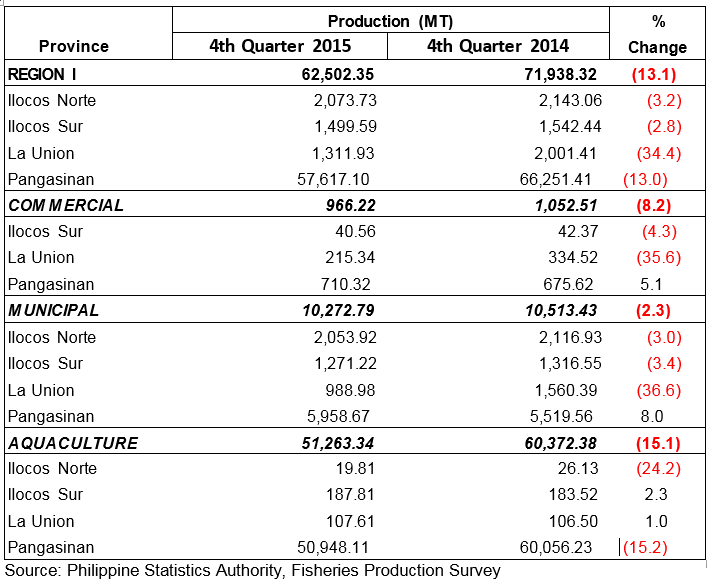
The aquaculture sub-sector contributed 82.0 percent to the total fish production of Region I in 4th quarter 2015. The municipal sub-sector, which comprises the marine and inland municipal fisheries, shared 16.4 percent. Meanwhile, the commercial fisheries shared 1.5 percent to the total output.
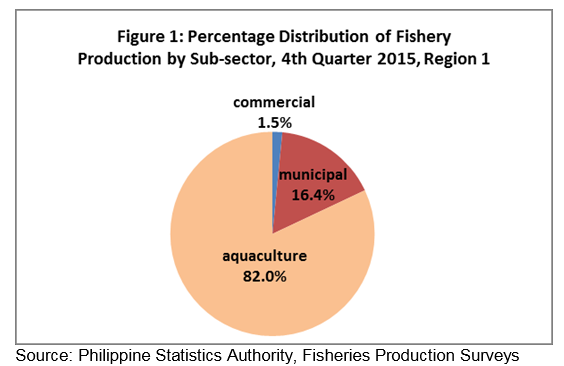
In terms of provincial distribution, the province of Pangasinan shared the bulk of production of about 92.2 percent. However, with the decrease in its aquaculture production, the total output for the province was lower by 13.0 percent from 66,251.41 metric tons in 4th quarter 2014 to 57,617.10 metric tons this 4th quarter 2015.
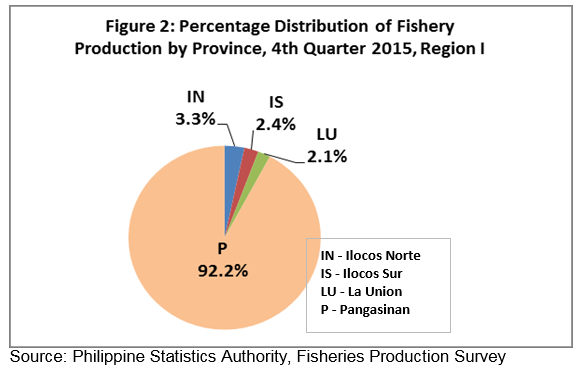
The province of Ilocos Norte, which shared 3.3 percent to the total fishery production of Region I, also posted negative growth in the fourth quarter 2015. Its output in 4th quarter 2015 of 2,073.73 metric tons was lower by 3.2 percent than the output in 4th quarter 2014. The decrease in production was contributed by both municipal and aquaculture sub- sectors.
The fishery production of Ilocos Sur also registered negative growth of 2.8 percent due to the lower output of its commercial and municipal fisheries. The province posted a production of 1,499.59 metric tons in 4th quarter 2015. It contributed 2.4 percent to the total fishery production of Region 1.
The province of La Union, which shared 2.1 percent to the total fish production in the region, registered lower overall fishery production in fourth quarter due to the decreased output of the commercial and municipal fisheries sub-sectors. Its total output of 1,311.93 metric tons was 34.4 percent lower than its output in 4th quarter 2014 of about 2,001.41 metric tons.
Commercial Fisheries
Commercial fishery production of Region 1 registered negative growth during the Fourth Quarter 2015. Production decreased by 8.2 percent from its output in 4th quarter 2014 of 1,052.51 metric tons to 966.22 metric tons in 4th quarter 2015. This was contributed by the provinces of Ilocos Sur and La Union. The lower production was attributed to lesser fishing operations due to rough seas caused by Typhoon Lando, and “Hanging Habagat” and “Amihan”. Lesser units of payaos harvested also contributed to the decline in output.
Meanwhile, fishery production of Pangasinan increased by 5.1 percent from its output in 4th quarter 2014 of about 675.62 metric tons. The presence of school of fish, efficient use of fishing gears like drift net and danish seine, and increased number of payaos harvested are the factors that contributed to the positive growth of output.
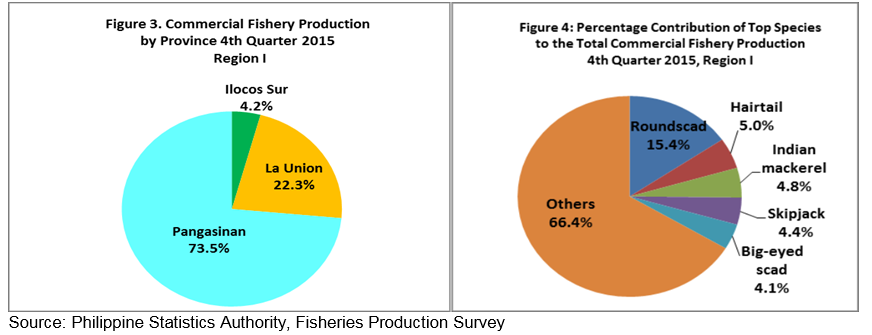
In terms of provincial shares, Pangasinan accounted for 73.5 percent of the region’scommercial fishery production, followed by La Union, 22.3 percent share, and Ilocos Sur, 4.2 percent share.
The top five major catch in the region during the fourth quarter 2015 were Roundscad, Hairtail, Indian Mackerel, Skipjack, and Big-eyed scad.
Municipal Fisheries
The overall municipal fisheries production of Region I in the 4th quarter of 2015 posted a decline of 2.3 percent. From its output of 10,513.43 metric tons in 4th quarter 2014, it went down to 10,272.79 metric tons in 4th quarter 2015 attributed to the decrease in the marine municipal fisheries.
Marine Municipal
Typhoon Lando, lesser school of fish, and smaller sizes of catch.
Table 2. Marine Municipal Fisheries Production, 4th Quarter 2015
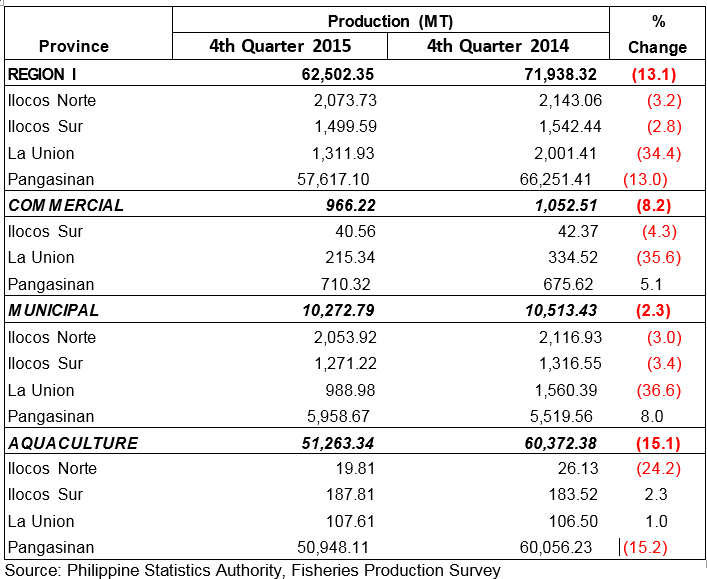
The province of Pangasinan contributed 59.0 percent of the region’s marine municipal fish catch in 4th quarter 2015, followed by Ilocos Norte with 20.5 percent share, Ilocos Sur, 11.6 percent share, and La Union, 8.9 percent. Meanwhile, yellowfin tuna, flying fish, skipjack, squid, and cavalla were the dominant catch in the marine municipal waters in the region in 4th quarter 2015.

Inland Municipal Fisheries
Table 3. Inland Municipal Fisheries Production, 4th Quarter 2015

By province, Pangasinan ranked first in the production of Inland municipal fishery during the fourth quarter 2015 with 38.7 percent share, Ilocos Sur, 27.3 percent share, La Union with 24.2 percent, and Ilocos Norte with 9.8 percent. The top five major catch in the region in 4th quarter 2015 were tilapia, freshwater (FW) goby, endeavor prawn, freshwater (FW) crab, and mudfish.
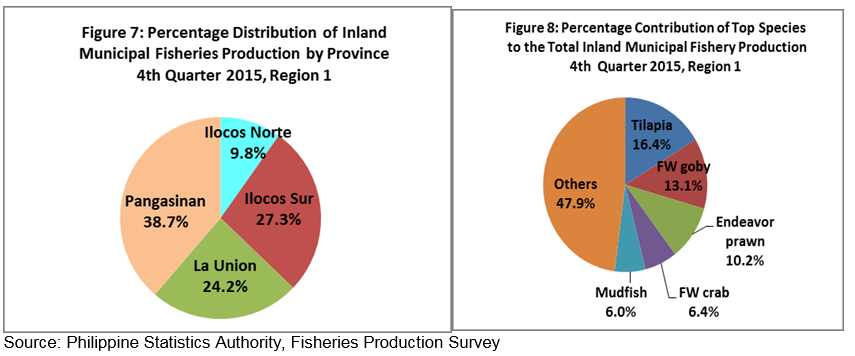
Aquaculture
Aquaculture production of Region 1 registered a negative growth of 12.9 percent in 4th quarter 2015. From the 60,372.38 metric tons production in 4ht quarter 2014, it went down to 51,263.34 metric tons in 4th quarter 2015. The provinces of Ilocos Norte and Pangasinan posted lower production. The overall decline in output was attributed to lesser stocking rate, smaller sizes, overflowed fishponds and cages during Typhoon Lando, lesser area harvested as some were not stocked due to lower water level and some others were just newly set.
Table 4. Aquaculture Production, 4th Quarter 2015 and 4th Quarter 2014 Region I

The province of Pangasinan (P) shared the bulk of aquaculture production with 99.4 percent. The remaining 0.6 percent was shared by Ilocos Sur, La Union, and Ilocos Norte. By culture type, aquaculture in Region 1 was dominated by Marine cages which accounted for 81.2 percent of the total production. However, production in this culture system decreased due to late setting, and some stocks overflowed during Typhoon Lando. It was followed by Brackishwater fishpond with 9.8 percent share, Marine pen, 5.6 percent, Freshwater fishpond, 1.8 percent, and Oyster, 1.0 percent.
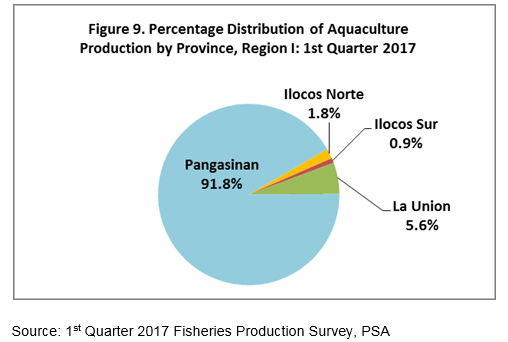
Milkfish dominated the aquaculture production of Region 1 with a share of 93.5 percent. Its production in 4th quarter 2015 was posted at 47,939.38 metric tons or 15.5 percent lower than its production in the same quarter last year. There were decreases in the production of Brackishwater fishpond, Freshwater fishpond, Marine pen, and Marine cage. The overall decrease in output was attributed to decreased area harvested as some were set late, lesser stocking rate, and smaller sizes of harvest due to hot weather. Production of Milkfish in the region for the fourth quarter 2015 came mostly from Pangasinan.
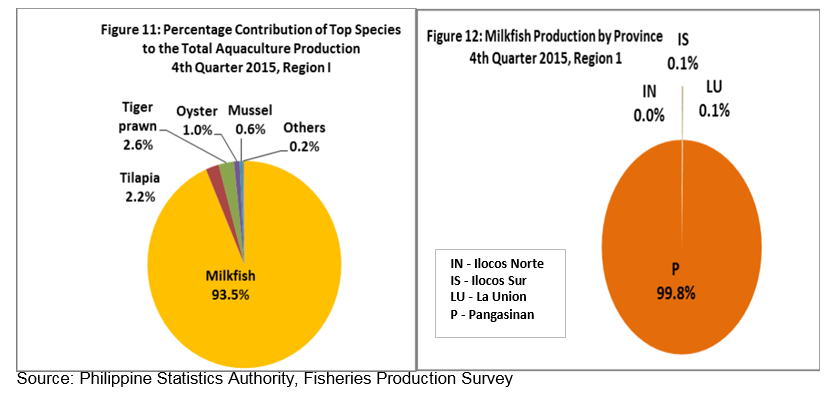
TECHNICAL NOTES
-
The Fisheries Production Survey of the Philippine Statistics Authority (PSA) is divided into four (4) major fisheries surveys. These are the Quarterly Commercial Fisheries Survey (QCFS), Quarterly Municipal Fisheries Survey (QMFS), Quarterly Inland Fisheries Survey (QIFS) and Quarterly Aquaculture Survey (QAqS). The commercial and municipal fisheries surveys aim to provide quarterly data on volume and value of fish production by species, by region and by province. The aquaculture surveys are intended to generate quarterly data on volume and value of cultured species by environment, by type of aquafarm, by region and by province.
-
The survey on commercial fisheries production covered 57 provinces and cities. For municipal fisheries and aquaculture surveys 81 provinces and cities were covered.
-
The sampling frames for the surveys of commercial and municipal fisheries were established in 2000 through a nationwide listing of landing centers (LCs). Updating of the lists was conducted over the years. The design used was a two-stage stratified random sampling with the landing centers as the first-stage sampling units and the fishing boats as the second stage sampling units. The landing centers were stratified based on volume of fish unloaded. The province was the domain of the survey. Inland municipal fisheries included fishing in inland waters such as lakes, rivers, dams, marshes, swamps, etc. Household engaged in inland fishing was the unit of enumeration. For aquaculture survey, the lists of brackishwater fishponds, freshwater fishponds, freshwater fish pens/fish cages, marine fish pens/fish cages, oyster/mussel and seaweed farms by province served as the sampling frames. Updating of list frames for aquaculture was done simultaneously with the landing center during the previous years. With the support from the Bureau of Fisheries and Aquatic Resources (BFAR), Ilocos Region was able to conduct Aquaculture Farm Inventory (AqFI) in 2013. The aquafarms were stratified according to area. Simple random sampling was employed in the selection of sample aquafarms from each stratum.
-
Concepts and Definitions:Aquaculture – fishery operation involving all forms of raising and culturing of fish and other fishery species in marine, brackish and fresh water environment. Examples are fishponds, fish pens, fish cages, mussel, oyster, seaweed farms and hatcheries.Aquafarm – the farming facilities used in the culture or propagation of aquatic species including fish, mollusk, crustaceans and aquatic plants for purposes of rearing to enhance production.Brackishwater – mixture of seawater and freshwater with salinity that varies with the tide. Example are estuaries, mangroves and mouths of rivers where seawater enters during high tide.Commercial Fishing – the catching of fish with the use of fishing boats with a capacity of more than three (3) gross tons for trade, business or profit beyond subsistence or sports fishing.Fisheries – all activities relating to the act or business of fishing, culturing, preserving, processing, marketing, developing, conserving and managing aquatic resources and the fishery areas including the privilege to fish or take aquatic resources thereof (RA 8550).Fisheries Sector – the sector engaged in the production, growing, harvesting, processing, marketing, developing, conserving and managing of aquatic resources and fishing areas.Fish Cage – stationary or floating fish enclosure made of synthetic net wire/bamboo screen or other materials set in the form of inverted mosquito net (“hapa” type) with or without cover with all sides either tied to poles staked to the water bottom or with anchored floats for aquaculture purposes.Fishing Gear – any instrument or device and its accessories utilized in taking fish and other fishery species.Fishing Grounds – areas in any body of water where fish and other aquatic resources congregate and become target of capture.Fish Pen – an artificial enclosure constructed within a body of water for culturing fish and fishery/ aquatic resources made up of bamboo poles closely arranged in an enclosure with wooden materials, screen or nylon netting to prevent escape of fish.Fishpond – a body of water (artificial or natural) where fish and other aquatic products are cultured, raised or cultivated under controlled conditions. This is a land-based type of aquafarm. Note that the setting-up of fish cages in ponds does not make the operation of fish cage and at the same time a fishpond.Freshwater – water without salt or marine origin, such as generally found in lakes, rivers, canals, dams, reservoirs, paddy fields and swamps.Inland Municipal Fishing – the catching of fish, crustaceans, mollusks and all other aquatic animals and plants in inland water like lakes, rivers, dams, marshes, etc. using simple gears and fishing boats some of which are non-motorized with a capacity of three (3) gross tons or less; or fishing not requiring the use of fishing boats.Landing Center – place where the fish catch and other aquatic products are unloaded and traded.Municipal Fishing – covers fishing operation carried out with or without the use of a boat weighing three (3) gross tons or less.
·

